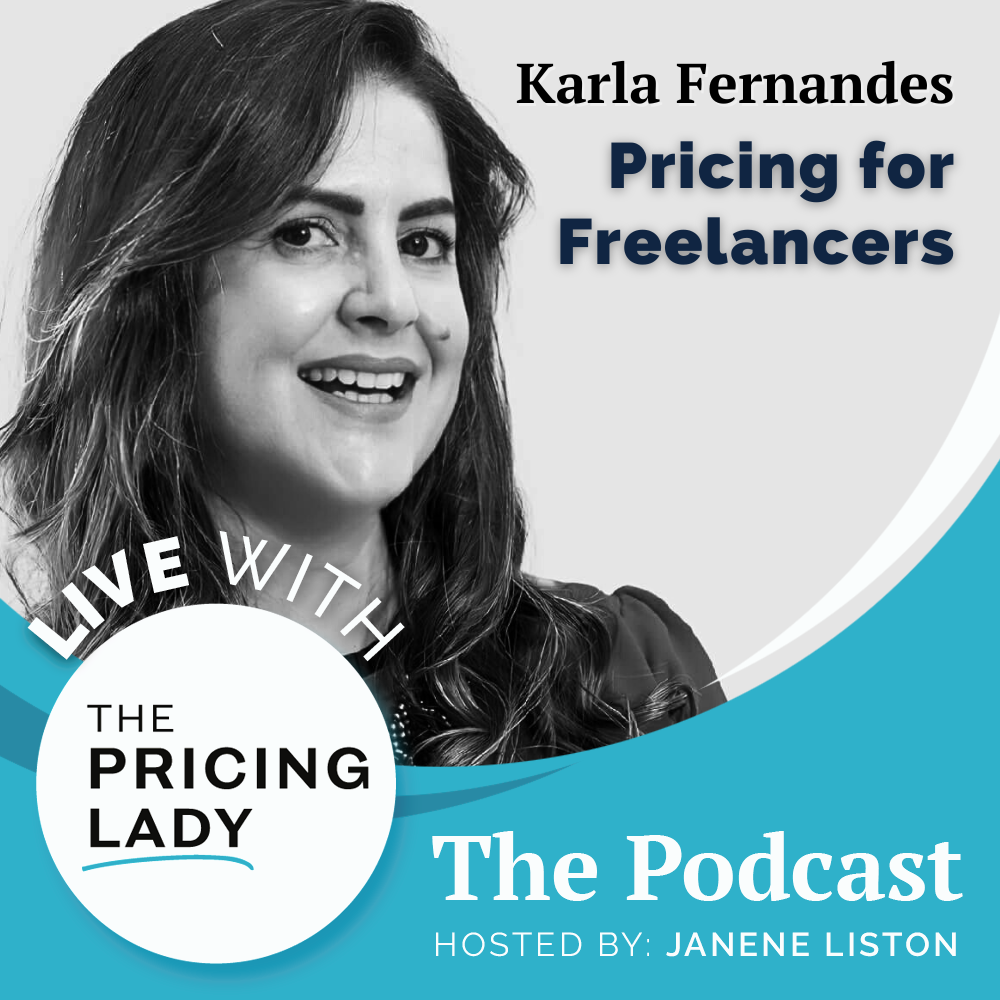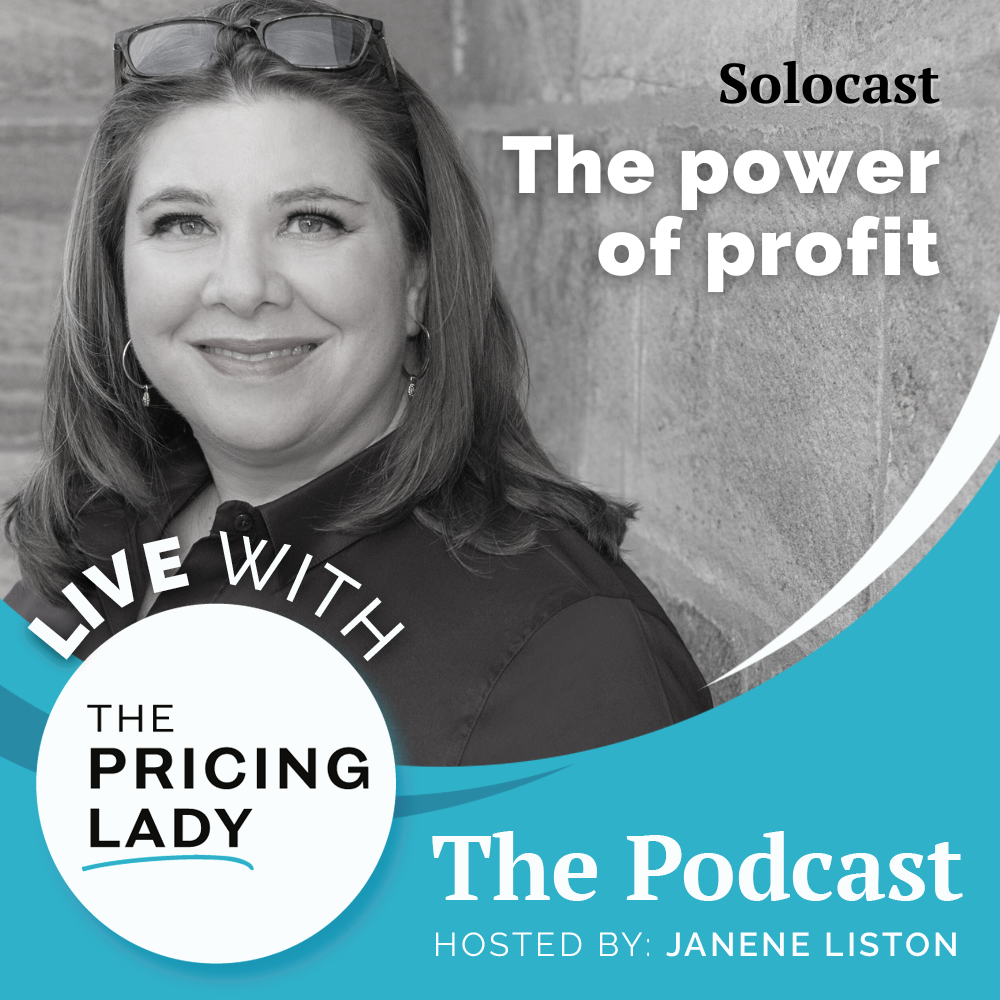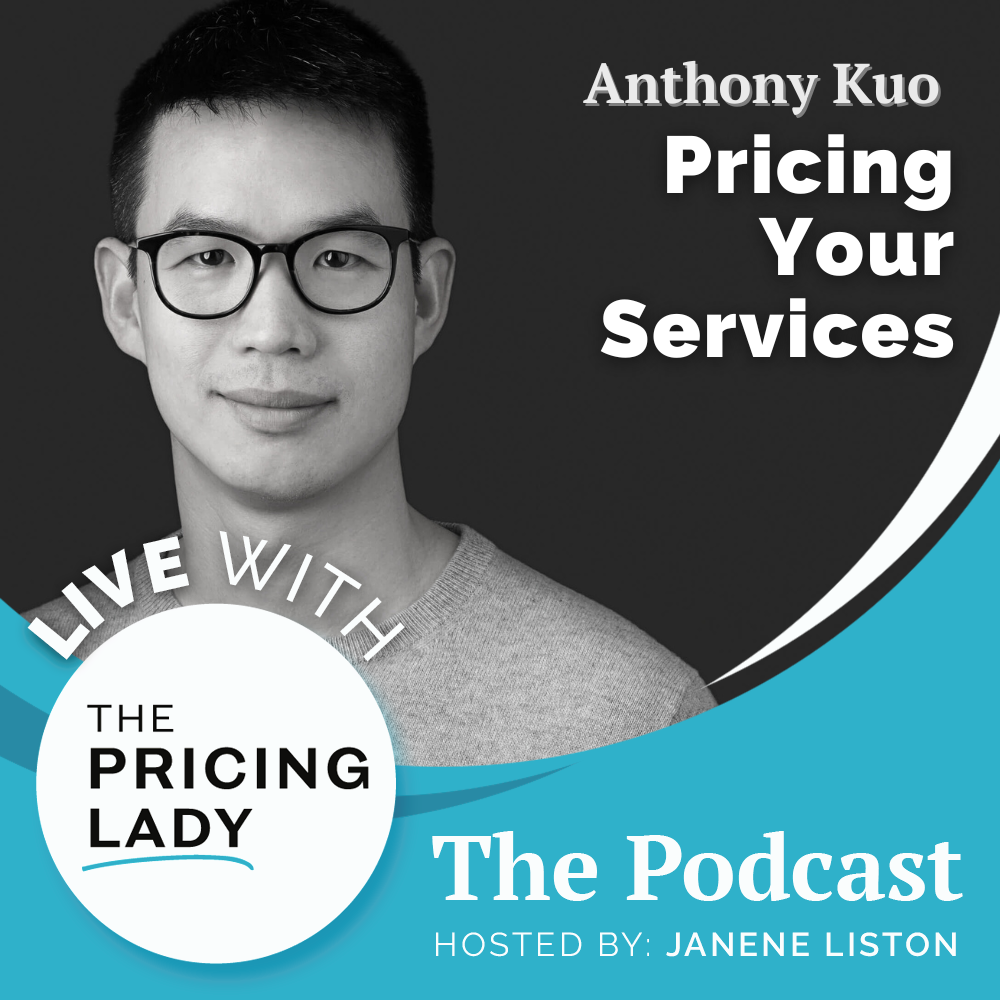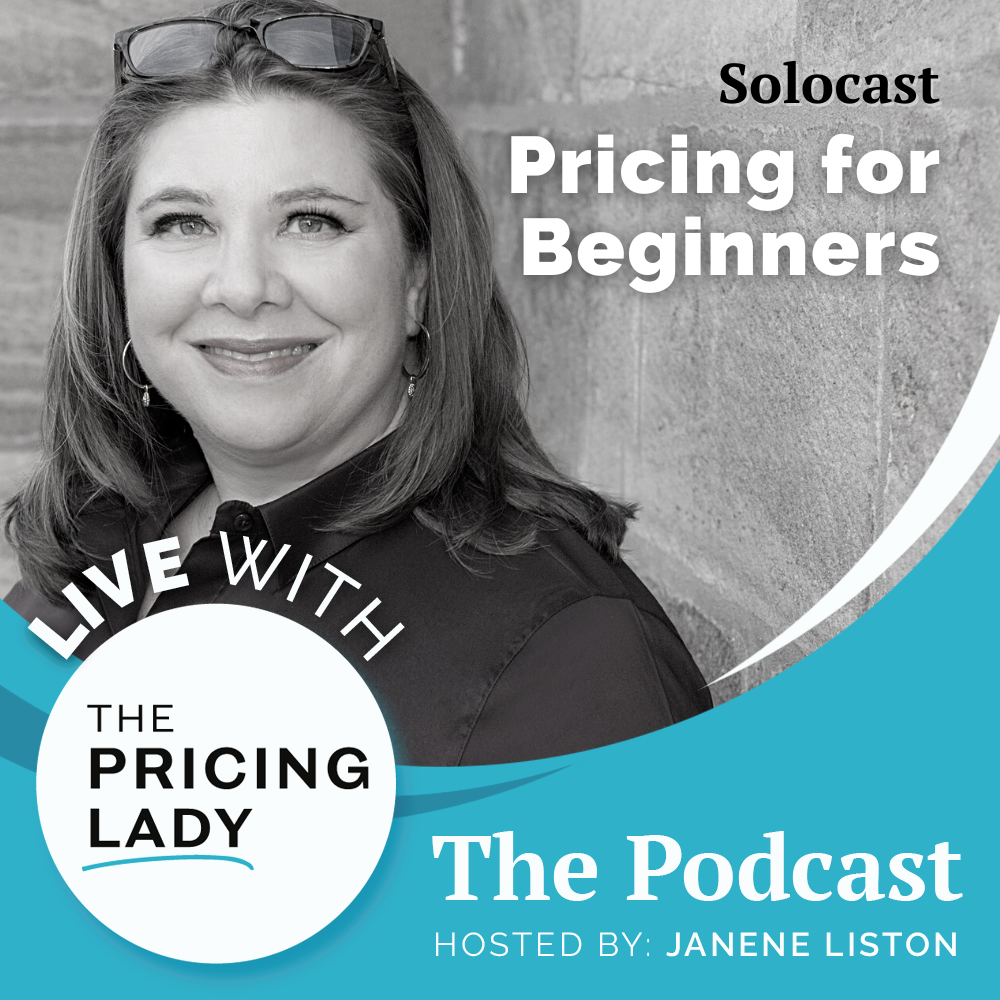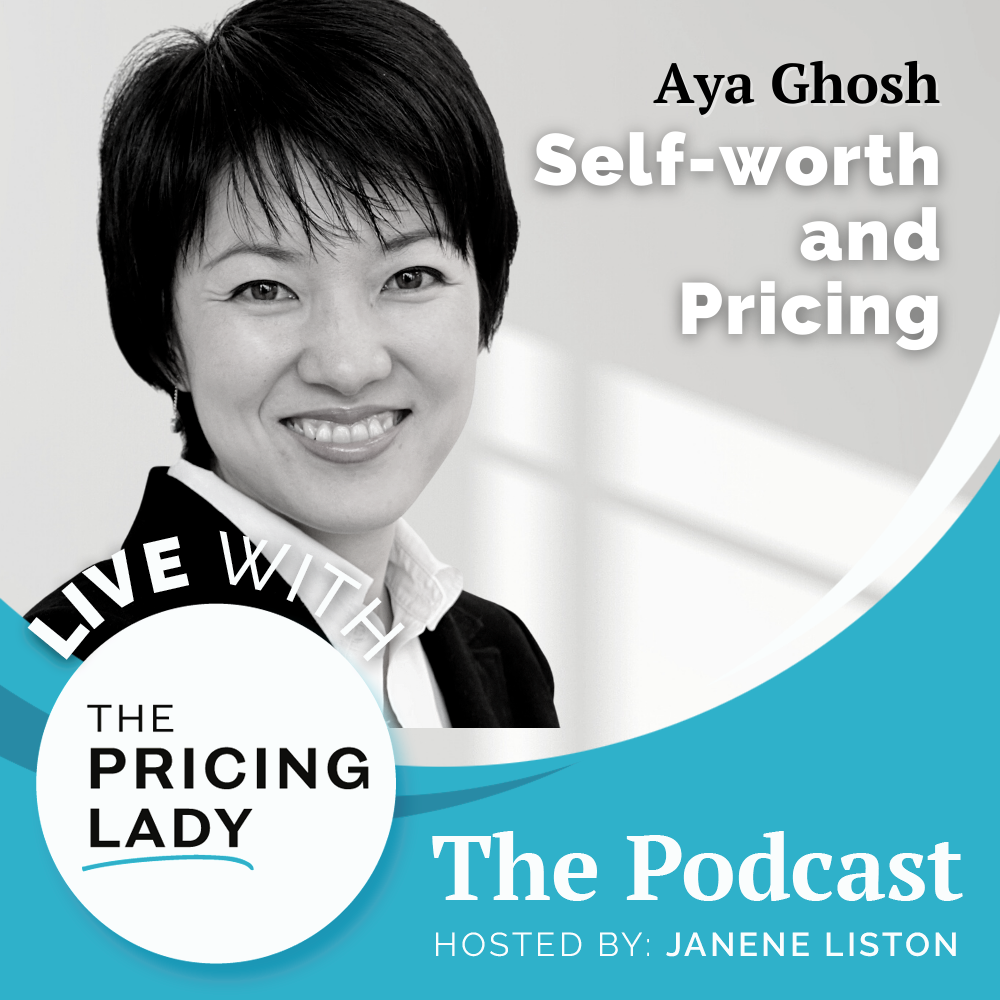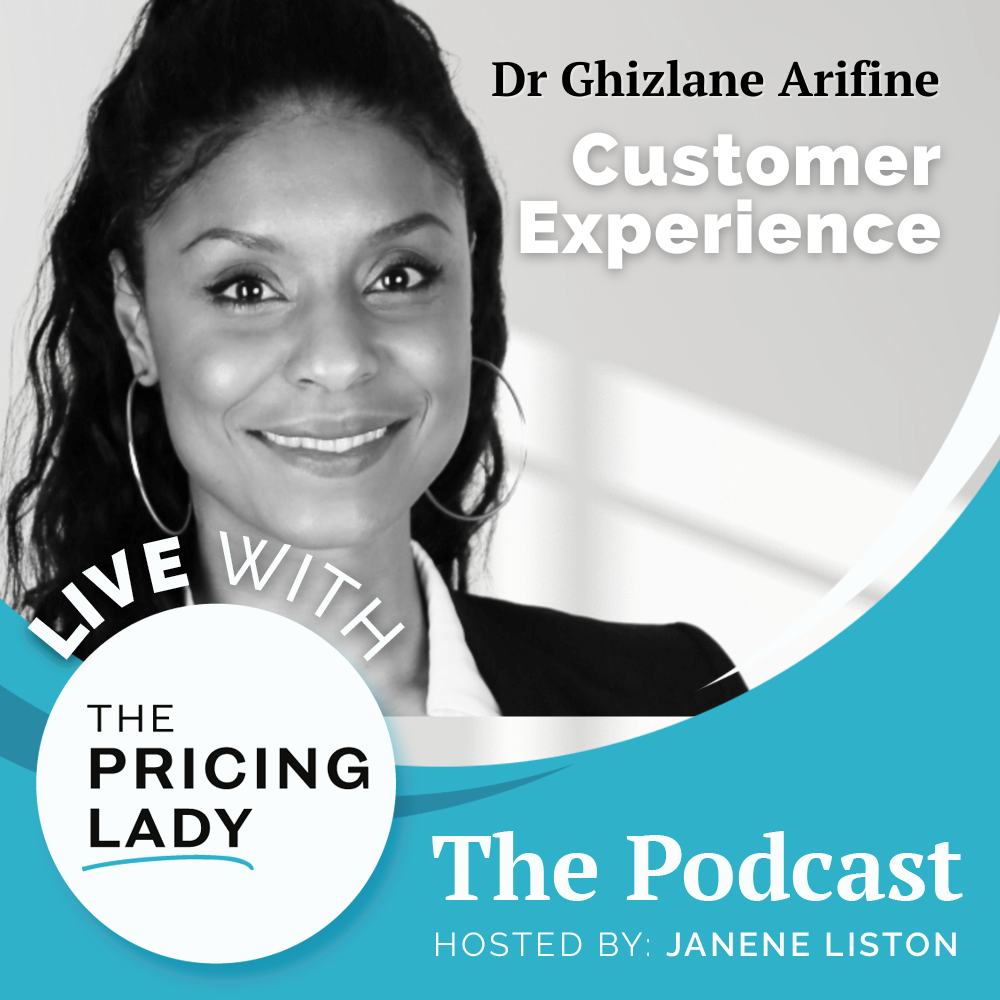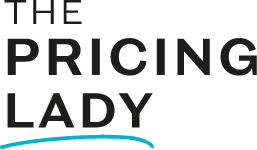“It took me a long time to realize the value I delivered.”
Reality is if you don’t value what you deliver your customers, chances are no one else will either.
Too often business owners don’t really believe in what they deliver. On the surface they say and do seemingly the right things, but at a deeper level that lack of certainty is silently sabotaging their efforts. In order to price what you offer the right way, not only do you need to know the value you need to believe it as well.
People often say I love what I do, so how can I charge for it. Or I’m an social entrepreneur so I want to be fair, but they end up being unfair to themselves. That’s not fair. Even charities need to consider the value they deliver. Each and every enterprise needs to understand the value they deliver. And you need to ask yourself “what’s the value I deliver?”
If you prefer to watch in video format, go here.
In this episode
I sat down with special guest Joy Foster, Founder of TechPixies Ltd. TechPixies helps women upskill with social media in order to return to work, change careers or start a business. Joy says about her own business journey, “It took me a long time to realize the value I delivered.” As you’ll hear in the interview her success wasn’t overnight and it did take internal work get where she is today.
You’re going to love this interview. She’s got great experience to share and there’s so much to learn from. Click the image above for the video or listen to the podcast below.
Here are the highlights:
Note: Time stamps are relevant to video and not the podcast audio.
- 0:58 Getting to know Joy
- 1:33Where her story began
- 4:16 Her first business
- 5:01 Business #2
- 7:00 Ready to scale & grow
- 10:12 Know your numbers
- 12:18 How’d you know you were undercharging
- 19:44 But I’m a social enterprise!
- 20:40 The cost of free
- 25:17 Be brave
Great quotes from the episode:
“I think my first exercise in pricing was, I hate sales, I don’t feel good enough to charge for it and why should I charge for something that I love?” Joy Foster
“One of the reasons that I targeted small charities with low budgets is I didn’t think I was a good enough web developer to go for bigger contracts.” Joy Foster
“I actually made it really hard on myself. If I had started with a higher price from day one, it would have been a lot easier than it ended up being. It took me a long time to go to get my pricing up to where actually the pricing covers the cost of the business. It gives us the margin to grow the business.” Joy Foster
“Here’s the lesson I learned as well. If you give someone something for free, the likelihood they’re going to do it is very slim.” Joy Foster
“…when they want to hide from the financial side of their business, from talking and dealing with money and numbers, I liken it to putting your big girl panties on. You’re a business owner and you need to understand those things because that’s, what’s going to keep moving you forward into the future.” Janene
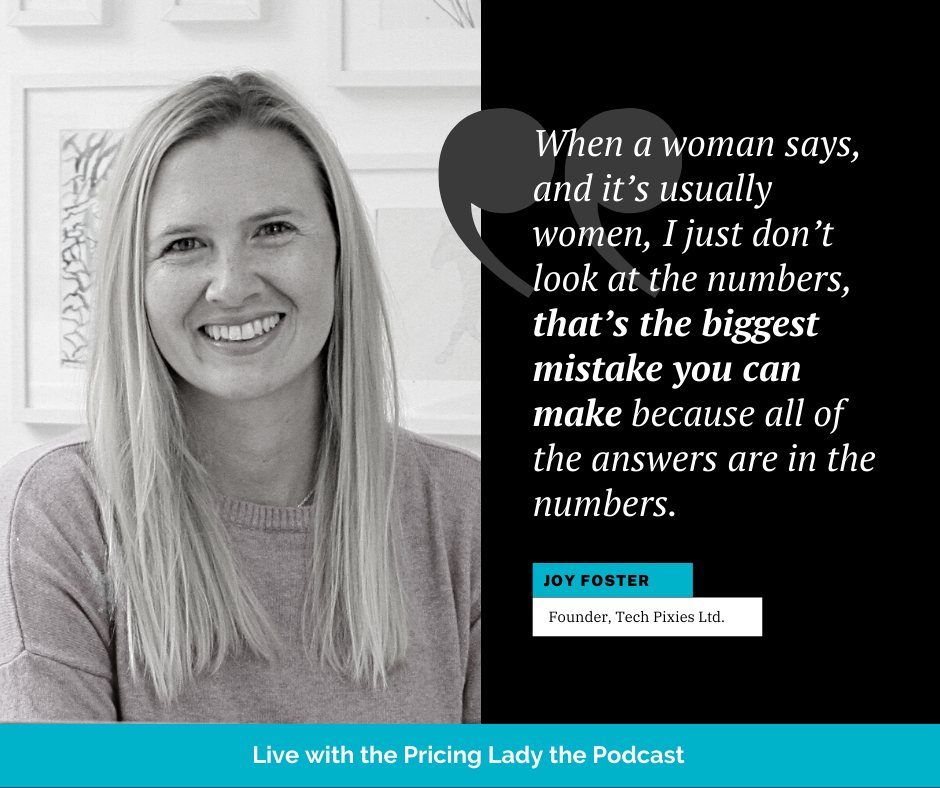
“Social entrepreneurs think ‘I can’t charge a commercial rate for my work.’ Right? Because it’s in the social space. It’s like running a charity. A social enterprise is not like running a charity because a social enterprise is taking a social problem and solving it with a commercial idea. You are still a commercial business person. You just have a social element to you.” Joy Foster
Links and how to contact Joy:
A few books Joy mentioned :
- Meant for More Lisa Sasevich
- Everything Is FIguroutable by Maria Forleo
- Illusion of Money by Kyle Cease
- Power of the Subconscious Mind by Joseph Murphy
- Rework by David Heinemeier Hansson
Reach out to Joy at www.techpixies.com.
Connect with Janene
Website | Linkedin | YouTube | Facebook | Email List
Get started improving your business. Sometimes it’s difficult to know where to begin. I suggest you Download the the self assessment Pricing Scorecard. Get a view of what’s working and what’s not working when it comes to pricing in your business. Figure out where to start making improvements.
Get in touch with Janene, your Business Strategist & Pricing Expert. If you’ve got a business question that needs answering, a pricing challenge you’re facing or you have suggestions for future topics or guests, let me know. Your questions and insights often become episodes. Share yours with me and let’s see where it goes. Contact Janene.
Listen up! Don’t miss out. There’s a lot going on and you’ll want to be in the know. Follow my YouTube channel (rate it too please) so you don’t miss an episode of Live with the Pricing Lady or join my Email List.
Transform your business and life. My mission is to help you build a sustainably profitable business. One where you can confidently charge for the value you deliver. Curious about my coaching and consulting offers, check them out. Let’s see how we can work together. Book a complimentary Call.
Podcast Transcript
(Note: this transcript has been edited)
Janene: I’m very excited to have Joy here with us today. We’re going to be talking about how it took Joy so long to realize the value that she delivered. Joy, why don’t you start by introducing yourself?
[00:00:46] Joy: Okay, well, this should definitely be a don’t do what I did podcast. I think we’re going to, I’m going to lay out all of the things I did, you shouldn’t do. I’m the founder of tech Pixies. We teach women how to leverage social media in order to return to work, change careers, or start a business. [00:01:00] I’ve been running it since about October, November, 2015 as a pilot project.[00:01:05] Then we became a company in 2016 . And then I went and raised money in 2018 and moved the whole program online. And so we’ve been running online. Full-time pretty much for the last two years. And that’s been a lot of fun.
“I can’t help you.” And he escorted me out the door.
[00:01:17] Janene: Excellent. Well, it’s been very interesting getting to know you over the past what month or so, and again, I’m thrilled to have you here on the show. Why don’t we start this conversation, with , how you started your business and what was it like when you first started, having to do or realize you needed to do pricing in your business?
[00:01:38]Joy: Like I said, I made a lot of mistakes. I ended up running my own business because I couldn’t find a job that would work with what I wanted in life.
[00:01:47]I just gotten married and I was in a recruiter’s office and I wanted to basically get a job and be a mother. I thought, well, I’m getting married I’ll probably want to have children. So in the recruiter’s office, I [00:02:00] asked, ” how do I find companies that have a good maternity policy?”
[00:02:04]He literally walked me out of the office and was like, “I can’t help you”. That was kind of my very Fast introduction to the corporate world and how they felt about maternity leave and mothers. And so I found myself kind of a home in a foreign country. I was living in Switzerland, which I think you are living in Switzerland.
[00:02:20] I was the trailing spouse. I had a husband who was there on work. I was a little bit at a loss. Because I then did find myself pregnant and I couldn’t get a job. And I was like, well, what am I going to do? So I learned German. And then I worked out that a lot of people were living in Switzerland that didn’t actually speak German and they needed the information about how to live in the area we lived in.
I was just helping people at the start
[00:02:40]I just started translating the websites and helping answer questions. I think the first lesson is …you want to solve a problem? Right? I was solving a problem that people had. The funny thing is, is I didn’t think I had a business. I just wanted to help people. What we need to identify here is how many women are helping people [00:03:00] and they don’t think it’s a business. If it is taking your time away from your family and it’s taking your time away from your ability to work in a paying job, then you have a business. The only difference between being a volunteer and a business is the exchange of money. I would really encourage women to think about what they’re doing. A lot of people think, if this is easy to me and if I enjoy doing it, I shouldn’t be able to charge for it.
[00:03:25] That’s a place I sat for a long time. How can you charge for something that you absolutely love? Because bearing in mind, a lot of my jobs up to that point, I haven’t been paid well for it, but I didn’t love, so I kind of acquainted getting paid to doing something I didn’t love versus getting paid to doing something that I did love.
[00:03:42] That was a huge transition I had to make. And so the first business I set up, I will just admit I made zero money for five years. Now let me just rephrase that. Organization that I set up. So I set it up as a nonprofit charity. The organization made money, [00:04:00] but I never took a pay cut.
[00:04:01]Not only that, but I put my own money into setting it up. And I only just about got that money back.
I hated sales
I think my first ex exercise in pricing was I hate sales. I don’t feel good enough to charge for it. And why should I charge for something that I love? And I would say it was, why should I charge for something that I love doing? That’s probably the more that was where I really struggled on charging.
[00:04:26] When I set up my second business though, then I said, okay, I’ve got to pay myself. Right. I’m going to pay myself something. But what I did was I undervalue myself. I set up a web development agency, building websites for charities. Again, staying in that kind of charity, nonprofit sector, always wanting to do good, always wanting to make life better for other people.
[00:04:44] That was where I was. I didn’t feel like I was good enough to charge. One of the reasons that I targeted small charities with low budgets is I didn’t think I was a good enough web developer to go for bigger contracts and things like that. So there was…
[00:05:00] [00:05:00] Janene: where do you think that came from?
[00:05:02]Joy: Not understanding how business works. It came from that when you’re in an employed role, which I had been up until that point in my previous career, I had always been in a paid role and I always got paid by somebody else. I never understood how they were able to pay me. Does that make sense? I kind of saw how that worked, but you look at your job if you’re getting paid and you don’t really think, where did the money for this job come from?
[00:05:32] Right. What budget does my salary come out of? You don’t think about that. I had a hard time switching from the employee to the boss.
It wasn’t scalable
[00:05:41] Janene: That’s a common thing. Most people have come from having a job. That mindset shift is really an important — you think differently when you own your own business.
[00:06:00] [00:06:00] Joy: Yeah. Like I said, the first time it was like, how can I get paid for doing something that I love? The second time is I’m not good enough to charge what I should be charging.
[00:06:09]Then that got to a point where I decided to scale the business and it was not a scalable model. And what do I mean by that? I mean, like there was a limit to how much money I was ever going to make with that business. There was a limit to how much impact I was ever going to make, because at that point I had decided I was a social entrepreneur and then I was going to create a commercial solution that solved the non, you know, like a social problem, basically.
[00:06:36] The way that I’d set up, that business was not scalable. It was a great job for one or two people to do and have one or two assistants. And that was it. That wasn’t where I wanted to go impact wise. That’s when I set up Tech Pixies.
[00:06:55] Even though I was taking a salary, it took me a very long time to charge [00:07:00] what the course was worth. One of the problems I ran into a lot was that I was selling, but the price was so low. I wasn’t able to cover the overhead which meant I had to take out loans and raise money.
[00:07:14] I actually made it really hard on myself. If I had started with a higher price from day one, it would have been a lot easier.
It too me a long time to get my pricing to where it covered the business
It took me a long time to get my pricing up to where actually the pricing covers the cost of the business.
[00:07:31] It gives us a margin to grow the business. You could probably still argue that there’s some room to, to raise the prices, but we’ve decided based on where the consumer is and what the environment is like, that we feel comfortable with what the price is right now. We’re looking for other ways to fund the growth of the business, but it does, it does.
[00:07:47] It is an interesting place to be and, and understanding how to price is very difficult to. What to charge is very difficult.
The numbers bit didn’t come naturally
[00:07:55] Janene: Was that natural for you to understand that financial side of the business [00:08:00] and sort of, you know, this trade-off, well, if I charge this, then I can reinvest that over here. Was that something that came naturally for you?
[00:08:08] Joy: Absolutely not.You know, the emoji with the monkey that’s go his hands on his eyes? That’s me with the finances. I was always in sales. I was always in customer support. I was always in social media. I was, I was always with people and I just love people.
[00:08:24] I still love people. My role has switched to being a coach. I’ve got neuro coaching, training and qualification now. My role is solving problems and coaching people through problems like that is my bag. I’m really good at that bookkeeping. Is not my strength, accounting, not my strength.
[00:08:42]Financial forecasting, really not my strength. And breaking down the product by by what things cost and our overhead expenses and working out what’s variable and what’s fixed really not my bag. I have learned how to do those things mostly because I didn’t do it correctly.
[00:08:59] I had to clean [00:09:00] up huge messes when you don’t do those things. I think when a woman says, and it’s usually women when a woman says, I just don’t look at the numbers, like that’s the biggest mistake you can make because all of the answers are in the numbers. Now what’s happened is I got help with the numbers.
I got help to understand the value I delivered better
[00:09:15] First step was asking for help. The second step was actually hiring people that could do it for me. I would say certainly with finances, you have to hire people who are trained and who’ve got certifications in those areas.
[00:09:30]I did the bookkeeping myself for awhile, and then when I switched to a CPA. It was amazing, she just transformed everything financially for us. Knowing where your strengths and weaknesses are, and then not staying in the weaknesses longer than you should as a really big.
[00:09:45] Janene: Right. It’s funny because when people… and you’re right, I think this is more common with women. Although I do have male clients who struggle in a similar sense, but when they just want to hide from the financial side of their business, from [00:10:00] talking and dealing with money and numbers, liken it to kind of
[00:10:03] putting your big girl (or boy) panties on. We talked about you’re a business owner. You need to understand those things because that’s, what’s going to keep moving you forward into the future.
[00:10:16] Joy: Absolutely. The thing is, is financial forecasting is really important.
[00:10:22] There’s a great book called Rework. Which is done by the guys who set up base camp. One of the things they say is you do not need an 18 page business plan. You need a one-page business plan. You just need to know what you’re doing
[00:10:40] Here’s the draft of what we’re going to do because things change really fast. Things change all the time and what we were doing last year, we’re not doing this year. We have to be able to pivot quickly in order to move forward to that.
How did you know there was a problem?
[00:10:54] Janene: Right. Joy, what was it that clued you in to the fact that [00:11:00] you were undervaluing yourself?
[00:11:03] Joy: Okay, well, this is, this is a great question. I think part of this stems from being a social entrepreneur, right. We’ve just had a live question come up around the social entrepreneur mindset. One of the things that social entrepreneurs think is that I can’t charge like a commercial rate for my work.
[00:11:17] Right. Because it’s in the social space. It’s like running a charity. A social enterprise is not like running a charity cause a social enterprise is taking a social problem and solving it with a commercial idea. You are still a commercial business person. You just have a social element to you.
One thing I’ve learned is that, I am a [00:12:00] social entrepreneur, but in that, in those two words is the word entrepreneur. One of the jobs of an entrepreneur is to create jobs, right? The best way to get the best people in the best jobs is to offer a commercial rate. You have to have an element of your product that is commercially viable. Otherwise it doesn’t work. That’s something that we’ve had to do.
[00:12:19] I think in terms of the confidence level, I should have had a lot more confidence sooner than I did. The very first pilot program we did with 12 women within a year, all 12 of them, all 12 of them had returned to work, change careers or started a business. The crazy thing is, is that we had women in that program, who’d been out of work for as little as six months and as much as 20 years .
I should have known the value I delivered earlier
[00:12:46] I think I should have known then that what I had was valuable, what I didn’t understand and what I didn’t get around my head was that I then had to translate the value to the customer. In some industries, it’s a [00:13:00] much easier to translate the value than others. You can just look around and say, Oh, well, this is what somebody else is charging for that.
[00:13:06] That gives you a pretty good idea. This industry it’s, you know, there are online courses in social media and there. Anywhere from like 10 pounds all the way up. Yeah. You’re like, well, where do I fit on there? And I think what I had to start understanding was the value of the live coaching that we do.
[00:13:26] Our program involves a lot of live coaching and that’s actually where the value is. We have this, no question left behind rule and stuff like that. To be honest, the easiest way to test out your pricing is just to raise your prices. People are so scared of that. And the biggest TA pricing change for me was when I went from, I think it was like a seven or 900 pounds to 1500 pounds.
[00:13:53] That was a huge leap. And bearing in mind that to get to 900 pounds, I had gone up from [00:14:00] 180. Two 450 to 650 to 900. So already in my head, I was going from a product that was one 80 to 900. Then I had to go from 900 to 1500. I almost freaked out because that was, that was like doubling the prices. It wasn’t completely double the prices, but it felt like doubling the prices.
I was afraid and reached out
[00:14:23] I read a book called Fear is Not the Boss of You of you by Jennifer Allwood. I’ve interviewed her for the, the book club the Joy book club. I messaged her personally and I was like , I’m so scared to do this.
[00:14:32] She messaged me back and was like, you know, go for it. Right. It was incredible to have an author of a book that now is one of the top sellers in the U S actually reply back to me and kind of give me that encourage. Encouragement. I also did a coaching call with with a neuro coach, which now I’m certified as, and she really pushed me.
[00:14:51] She said, ” do I think my product is worth 10 times what you’re selling it for?” Well, yeah, because I knew that someone with the [00:15:00] skills that they had from the course, they could go get a job and they could earn that in a week, two weeks, a month, you know, they could get that money back.
[00:15:06] If you’ve got, let’s say you just earn the 1500 back in one month. You would be actually just in 10 months you could be better off. I was like, Oh my gosh. Yes, 100%. I believe that. So that helped me as well. Then my product helps people return to work. There is value in that because when they get a job or when they start a business and when they start earning, they actually get that money back.
Know your conversion rates!
[00:15:28] That helps. The last thing too is knowing our conversion rates. Knowing that our business model was working. Once we knew the business model was working, raising the prices was more of a fear issue that I had to overcome. I had a customer once when I was building websites and she was like, I can’t afford to pay you.
[00:15:44] And I said, well, you just told me that you booked out for the rest of the year. And she said, yeah. And I said, well, then you need to raise your prices because we developed a product so that you can afford me. It’s all around fear.
If you knew, then what you knew now, would you still start at one 80 and keep inching your way up or would you?
[00:16:10] Joy: Oh my gosh. I would’ve started at 650 or 450, because what I didn’t realize is the fact that I was doing live coaching was worth more.
[00:16:34] It’s the live coaching. That’s worth more, but. What all the coaching training I’ve done since then, they would say, if you ever launch a live coaching program for six weeks, right. I’m talking six weeks. If you do a live coaching program for six weeks, that is worth 600 pounds. Yeah. That’s what that is worth right now.
[00:16:52] Our program is you get access for 12 months. And you can repeat a six week program, six times. Really our [00:17:00] pricing, if you just were to go on that number, it were six times 600, but that’s really what we should, we should be charging 3,600 and we’re, we’re not even charging that yet.
Question from listener
We have a question here from Clemency. She says, “hi Joy. I’m struggling to find the balance between wanting to help others and be available to as many as possible, but equally make enough to make it viable. Any advice for mindset being a social entrepreneur.”
[00:17:33] Joy: That just goes back to what I learned from my online mentor, Amy Porterfield, which is your ideal customer is the one who pays you. That’s she learned that from Marie Forleo and Marie Forleo says that all the time. She even talks about the no train.
[00:17:53]The very first exercise when you do with Marie Forleo is learning how to get on the “no” train. How am I going to say [00:18:00] no to things? That’s a very powerful exercise because I started doing that. I started saying, no, I’m not going to do that. Nope. I’m not going to do that. Nope. I’m not going to do that.
[00:18:07] Getting clear on what you need to do to move the needle forwards and listen, if you’re a social entrepreneur, yes you want to help people. But a social entrepreneur solves a social problem with a commercially viable idea. A portion of your revenue can go back to solving a problem, or the recipients of your product can get it at a reduced price, which is what we do at tech Pixies.
[00:18:29] If someone’s on universal credit or PIP or ESA we give them a reduction in price, but they still have to pay. Here’s the lesson I learned. That is that if you give someone something for free, the likelihood they’re going to do it is very slim.
People don’t value free
In fact, Jennifer Allwood the book that I just told you about the, fear’s not the boss of me on the call.
[00:18:48] I was with on with her last night. She was talking about this because someone said, you know, a lot of people right now they’re really struggling and should I give it to people for free? She said, here’s what I did. I gave 10 courses away for [00:19:00] free. And she said, and I had my team go in and check how they, how those people did.
[00:19:05] What she found is that eight of the 10 people never even opened up the course. Then two of the 10 got through the first module and never got beyond it. There is a reason why people want things for free because they don’t value them. They’re not going to go. You don’t pay for it. We ask people, even if they’re below the poverty line, we ask them to pay a percentage towards the course, because we know that if they pay, they will pay attention.
[00:19:32] The first piece of advice, Clemency, I can give you is your customers are the ones who pay you and then how you choose to use that money to serve others is up to you. But you really want to work on the commercially viable part first, and then the social impact part second.
[00:19:48] Janene: Right. I mean, well, if you can’t find out find a way to generate cash and have a sustainable business, you won’t be able to be there to serve them later.
Don’t be a grant junkie
[00:19:57]Joy: Quite frankly, even in the social enterprise world like we [00:20:00] just applied for this huge grant. It’s from the inclusive recovery fund. They wanted to know that 80% or more of our revenue came from trading. Even though w they want an, and we have to have a mission lock in our in our legal documents that say 51% of profits will be reinvested.
[00:20:19] The reality is 100% of our profits are reinvested in our business, but we have actually a legal clause that says 51% of our profits are reinvested. The other side of that is that they, even the funders who want to fund us, they want a guarantee that majority of our revenue is not coming from grants.
[00:20:37] They call it grant junkies. You know, you don’t want to be a social entrepreneur who is also a junkie.
Being a charity or social enterprise isn’t different
[00:20:43] Janene: Quickly you become a charity. That’s one other thing I wanted to point out is that even if you’re starting a charity, you still have to figure out how you’re going to bring donations in. How you’re going to spend that money. How you’re going to sell people on the value of [00:21:00] supporting your charity. All the same principles apply.
[00:21:04] I’d like people to understand that. Just because it’s a charity or a social enterprise or a business, a lot of the things that you need to consider are the same in the end.
[00:21:15] Joy: That’s why you see some charities are doing very well right now. Some are struggling. It depends on how they offer their service and how they take care of their donors.
[00:21:25]
[00:21:25]That’s really important because when, everyone’s fighting for money and you’ve got to be able to show it. It’s interesting.My daughter, for Christmas a couple of years ago, she decided that she was going to give a portion of her money to one of the dog charities.
[00:21:48] I was thinking about them the other day. This is a brilliant charity, because they’ve taken her a small monthly donation, which is not a lot, but it’s something. She gets, a magnet with the [00:22:00] dog that she’s sponsored for the year. That sits on the kitchen counter. We see it all the time. We get a postcard quarterly showing the progress of the dog that she sponsored. We get pictures and the story of Marley, right? There’s also a way for charities to serve their customers in a way that they keep their customers for the next year.
[00:22:24] And they are customers in the sense that they’re exchanging money. Charities have to also be clever about how they do things.
Be brave
[00:22:31]Janene: Yeah. Yeah, no, that’s very true. So joy we’re coming to the end of our time here. If you could give people one word of advice or one sentence of advice, what is it that you would offer them when it comes to realizing the value that they deliver?
[00:22:48]Joy: Two words, actually there be brave. I think what we have to recognize is that there’s a huge amount of fear associated with pricing. There’s a huge amount of fear [00:23:00] associated with selling. There’s a huge amount of fear, you know, with growth in your business. There’s a huge amount of fear taking a salary for yourself.
[00:23:08] I think the first thing is to recognize that it is fear and just fear. Then the second thing is to do the work, to overcome the fear. So I can tell you a couple of books that really changed my life. In terms of overcoming fear, one was called the illusion of money by Kyle cease. Another one is called the power of the subconscious mind.
[00:23:27] I can’t remember who that was by. But that was also really good. Marie Forleo’s book. Everything is Figuroutable is also very good. Then in terms of sales, where a lot of people struggle with sales is you know, feeling like it’s slimy. I think the person that answers that and flips that on its head is at Lisa Sasevich with her book Meant for More.
Educating yourself
[00:23:47] That’s a really good one as well, but I think educating yourself is one of the first steps and then getting coaching, you know, I like I’m, I’m a neuro coach now and I work with a neuro coach. One of the things that I’ve learned is there [00:24:00] is a huge, there’s a ton of power, right?
[00:24:02] In your subconscious mind and think about your subconscious mind like this, your subconscious mind has no willpower whatsoever. It does what it’s told literally like it has no, it has no willpower. It has no mind of its own. It does what you tell it. What you have to do is if you want to change the outside world, you have to change the inside world. That starts with reprogramming your subconscious mind.
[00:24:27] That starts with awareness and just being aware. Okay. That you are scared of something means that you can then go find someone to help you overcome that fear. I’ll tell you what the biggest fear for me was raising the price as well. I had zero problem whatsoever raising the price.
[00:24:42]I told you I almost freaked out from 900 to 1500. I freaked out from 1500 to 2000. I literally didn’t even blink. I just did it. And from 2000 to 2397, I just did it. Right. I didn’t even, I didn’t panic about it. I didn’t even worry about it. I didn’t even tell the [00:25:00] investors I was doing it. I just did it.
[00:25:02] It was one of those things where it’s like, I felt so comfortable and confident with the price that I was like, yep. That’s what we’re doing.
You need to invest in the business
And then the second thing that that made a huge difference was, you know, once I knew how I was getting sales, it was doubling down on spending money on Facebook ads, for example, Huge amount of fear.
[00:25:19] I had to overcome with that. I we spent a lot of money on ads and I just, it was, it was more money than I’d paid myself in a year. I thought, well, how can I, how can I do that? Is it going to work? You know? Cause your brain goes to the worst case scenario. So always if your brain’s going to go the worst case scenario, that’s fine.
[00:25:35] But let it also come back to the best case scenario and think, well, what, what if this worked and what if. But if a hundred people signed up to what I’m selling, you know, what would that look like? And you know, now we’re thinking, well, what if the thousand people sign up to what we’re selling? What does that look like?
[00:25:51] What that looks like is a thousand people’s lives change. That’s what it looks like. If you spend your time focusing on what, what might happen, you might as well spend [00:26:00] your time focusing on what might happen in the positive, rather than what might happen in the negative. And you’re much more likely to get it.
Snowball effect
[00:26:05] Janene: Right. Right. Very good. Thank you so much for that. Those are some words of wisdom and to live by, I think not just in the context of pricing, but in many different contexts.
[00:26:17] Thank you so much for sharing with us Joy today. Sounds like it’s been a long and arduous journey. Yeah. You know, it’s good to point out at the end here is that, you know, we, we go through these phases and you come up to new challenges and new fears. If you’ve applied the skills that you’re talking about in the past, and they get easier to apply as you meet bigger and greater challenges along the way.
[00:26:45] Joy: Yeah. It’s like a snowball effect, you know, as we like to say about being brave, you know, if you’re brave ones and this is going back to Jennifer, Allwood like my favorite quote from her is, you know, Basically, well, Amy Porterfield says, if you don’t have the [00:27:00] confidence, grab the courage.
[00:27:01] I love how Jennifer follows that up with courage is doing something that you’ve never done before and realizing you didn’t die. That’s so important because I think people, they, they, without realizing it and again, your, your subconscious brain doesn’t know the difference between real death and imagined death.
You can face the fear
[00:27:21] And so when. When you’re making a decision that feels like fear, your subconscious mind is they’re equating it to real death when actually it’s just not really death. And so you’re, you know, her point is if you’re courageous and you do something you’ve never done before and you realize I’m still alive.
[00:27:37] Your brain goes, Oh, that’s not as bad as it was an art’s. It’s not as bad as I thought it was. Then if it works, your brain gets really excited and then it wants to do it again. What becomes unstoppable is when you’re very confident in what you have to deliver, that the, the service you have is good, that the, you know, people’s lives change it, and you charge what it’s worth.
[00:27:57]I think that’s when you see companies take off, [00:28:00] that’s, there’s an, there’s an alignment on the inside and the outside. Until that alignment happens, your business can’t take off.

